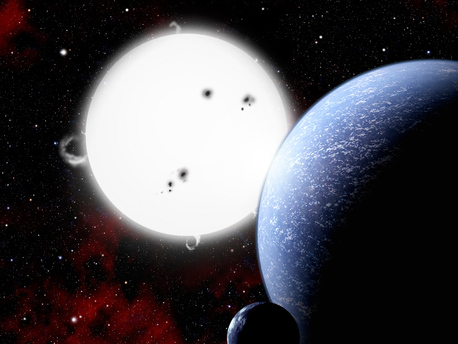New Exoplanets
New Massive Hunting Grounds For Exoplanets
 © David A. Aguilar, CfA
|
In this artist's conception, a hypothetical alien world and its moon orbit a hot, massive, type B star. Due to the short lifetime of such a star, complex life is unlikely to be found there. Although not good targets in the hunt for extraterrestrials, such planetary systems help give us a better understanding of planet formation.
Koenig and his colleagues examined the star-forming region named W5, which lies about 6,500 light-years away in the constellation Cassiopeia. They employed NASA's Spitzer Space Telescope and the ground-based Two Micron All-Sky Survey (2MASS) to look for infrared evidence of dusty planet-forming disks. They targeted over 500 type A and B stars, which are about two to 15 times as massive as the Sun. Sirius and Vega, not included in this study, are two type A stars easily visible to backyard sky gazers. Type-A and B stars are categorized by their spectral type (there are all in all 13 different types). Type-A stars having a white and Type-B stars a blue-white color.
The team found that about one-tenth of the stars examined appear to possess dusty disks. Of those, 15 showed signs of central clearing, which suggests that newborn Jupiter-sized planets are sucking up material.
"The gravity of a Jupiter-sized object could easily clear the inner disk out to a radius of 10 to 20 astronomical units, which is what we see," said Lori Allen of NOAO. (An astronomical unit is the average Earth-Sun distance of 93 million miles.)
Planet formation around A and B stars is a battle between opposing forces. On one hand, the stars' disks tend to be more massive and contain more of the raw materials to build planets. On the other hand, fierce stellar radiation and winds try to destroy the disks rapidly.
The stars in W5 are only about two to five million years old, yet most have already lost the raw materials needed to form planets. This indicates that, at least for type A and B stars, planets must form quickly or not at all.
The prospects for hypothetical alien life are disappointing. The habitable zone, or region where liquid water could exist on a rocky surface, is at a greater distance from the star for A and B stars than for sun-like stars due to their greater luminosity. However, that luminosity comes at the price of a short lifetime. A and B stars live for only about 10 - 500 million years before running out of fuel.
Life existed on Earth for 3.5 billion years in very simple forms, before the Cambrian explosion led to the diversity of life forms we see today. Planets in W5 around these more massive stars wouldn't have that opportunity.
"These stars aren't good targets in the hunt for extraterrestrials," said Koenig, "but they give us a great new way to get a better understanding of planet formation."
Source: Harvard-Smithsonian Center for Astrophysics (CfA)
New Exoplanets
New Massive Hunting Grounds For Exoplanets
 © David A. Aguilar, CfA
|
In this artist's conception, a hypothetical alien world and its moon orbit a hot, massive, type B star. Due to the short lifetime of such a star, complex life is unlikely to be found there. Although not good targets in the hunt for extraterrestrials, such planetary systems help give us a better understanding of planet formation.
Koenig and his colleagues examined the star-forming region named W5, which lies about 6,500 light-years away in the constellation Cassiopeia. They employed NASA's Spitzer Space Telescope and the ground-based Two Micron All-Sky Survey (2MASS) to look for infrared evidence of dusty planet-forming disks. They targeted over 500 type A and B stars, which are about two to 15 times as massive as the Sun. Sirius and Vega, not included in this study, are two type A stars easily visible to backyard sky gazers. Type-A and B stars are categorized by their spectral type (there are all in all 13 different types). Type-A stars having a white and Type-B stars a blue-white color.
The team found that about one-tenth of the stars examined appear to possess dusty disks. Of those, 15 showed signs of central clearing, which suggests that newborn Jupiter-sized planets are sucking up material.
"The gravity of a Jupiter-sized object could easily clear the inner disk out to a radius of 10 to 20 astronomical units, which is what we see," said Lori Allen of NOAO. (An astronomical unit is the average Earth-Sun distance of 93 million miles.)
Planet formation around A and B stars is a battle between opposing forces. On one hand, the stars' disks tend to be more massive and contain more of the raw materials to build planets. On the other hand, fierce stellar radiation and winds try to destroy the disks rapidly.
The stars in W5 are only about two to five million years old, yet most have already lost the raw materials needed to form planets. This indicates that, at least for type A and B stars, planets must form quickly or not at all.
The prospects for hypothetical alien life are disappointing. The habitable zone, or region where liquid water could exist on a rocky surface, is at a greater distance from the star for A and B stars than for sun-like stars due to their greater luminosity. However, that luminosity comes at the price of a short lifetime. A and B stars live for only about 10 - 500 million years before running out of fuel.
Life existed on Earth for 3.5 billion years in very simple forms, before the Cambrian explosion led to the diversity of life forms we see today. Planets in W5 around these more massive stars wouldn't have that opportunity.
"These stars aren't good targets in the hunt for extraterrestrials," said Koenig, "but they give us a great new way to get a better understanding of planet formation."
Source: Harvard-Smithsonian Center for Astrophysics (CfA)






